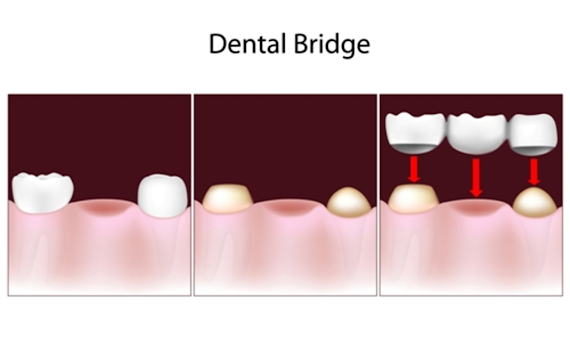Luckily, if you lose a tooth, it is not the end of the world. Sure, the ideal would be that you wouldn’t need a prosthetic procedure; however, people lose teeth for many reasons, and you should know about a dentist near you that can help you get your beautiful smile back.
Our dentist in SW Calgary will offer you a wide range of options to replace a missing tooth. Among them, there are dental implants, dentures, and dental bridges; and we will discuss the last one.
Dental Bridges in SW Calgary
Dental bridges are fixed dental prostheses made to fill the space where one or many teeth are missing. Most common bridges consist of dental crowns and an artificial tooth (pontic) in between.
What’s the Procedure?
First of all, your dentist will take an impression of your teeth; this way, he or she will have the right measures to manufacture the prosthesis. As we mentioned above, traditional dental bridges near you consist of an artificial tooth that is called a pontic, which will take the place of the missing tooth. Unlike dental implants, there is no post supporting the pontic; hence, it will be between two dental crowns, for support. Once the dental bridge is made, your dentist will install it.
The traditional bridge is the most popular one; however, there are other types. Let’s review them.
Types of Dental Bridges
1. Traditional Bridges
You probably know about this type of bridge since it is the most common. It is a custom-made replacement tooth that floats between two dental crowns; hence, you need to have the teeth next to the space in place; otherwise, the pontic would not have the necessary support.
2. Cantilever
These dental bridges are designed to be held only by one dental crown; therefore, they are perfect for when the patient doesn’t have two adjacent teeth in place. On the downside, they are not as strong as traditional bridges, which have twice the support.
3. Maryland
Like the traditional bridge, this type also uses a pontic to replace the gap of the missing tooth; however, instead of being supported by two dental crowns, it is adhered to the adjacent teeth using a metal framework. It is also called a resin-bonded fixed partial denture, and it is indicated in the replacement of a front tooth.
4. Implant-supported
If you are missing many teeth in a row, this might be a good option for you. Your dentist will evaluate how many teeth you are missing to determine if he or she can install an implant-supported bridge. Keep in mind that dental implants need to be integrated with the bone before placing any permanent restoration above them, and this process takes months. After the bone has healed, you will have your dental bridge installed.
If you made it this far, now you know about all the types of bridges you can choose from to replace a missing tooth. Every patient is different, which is why you should schedule a consultation with a specialist to explore what option is best for you, as under any circumstance, this blog does not intend to replace a consultation appointment with your dentist.
Our team will be more than happy to advise you and offer you many options, and together, determine which one suits your wants and needs. Contact us at your earliest convenience!
